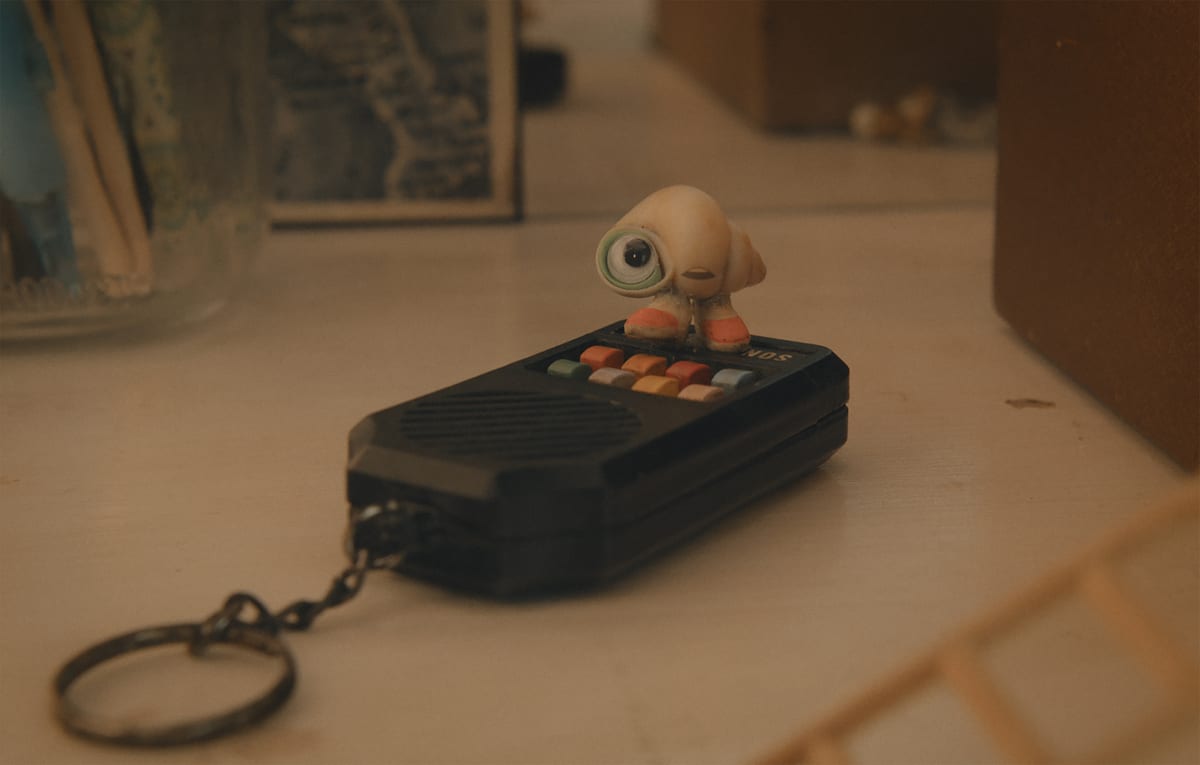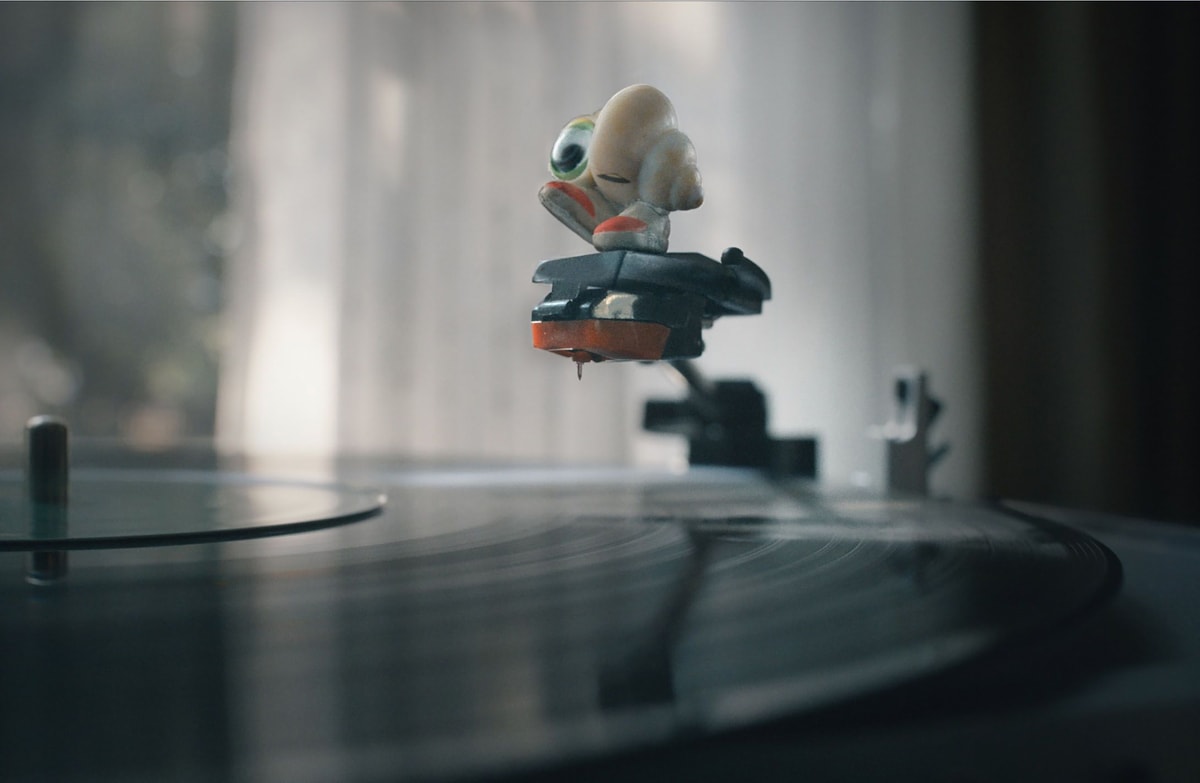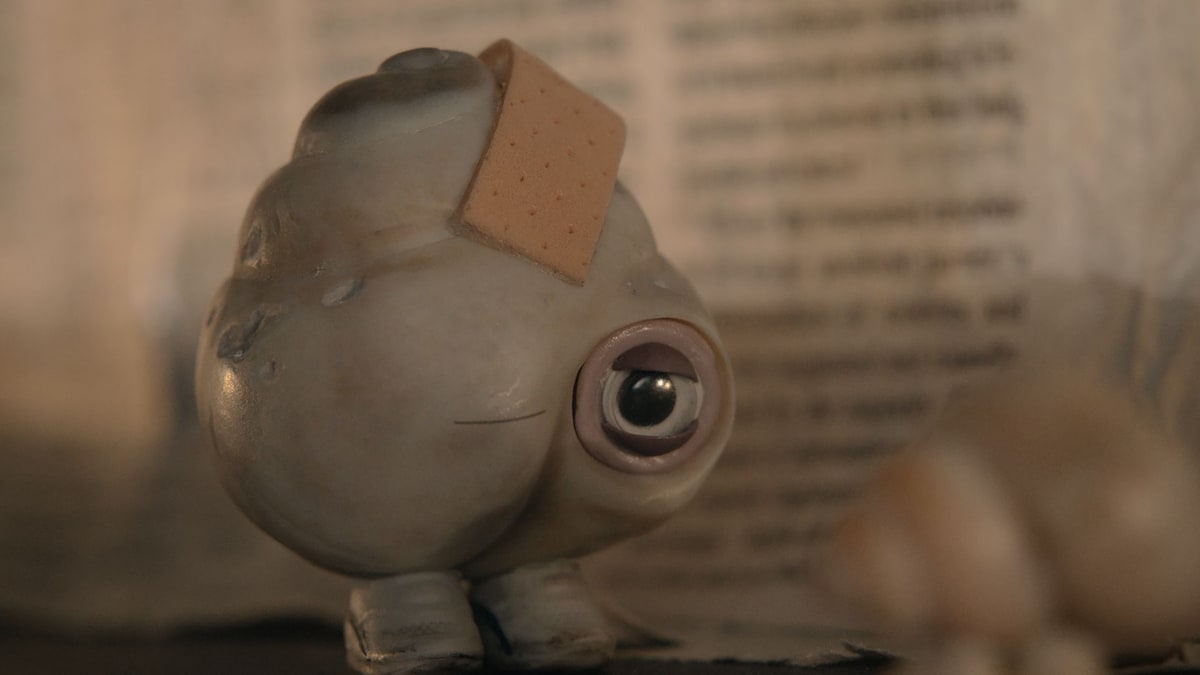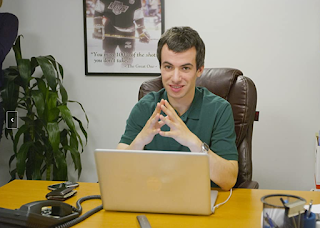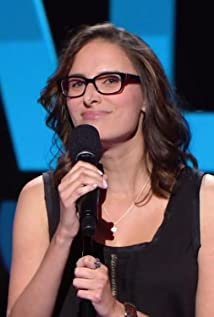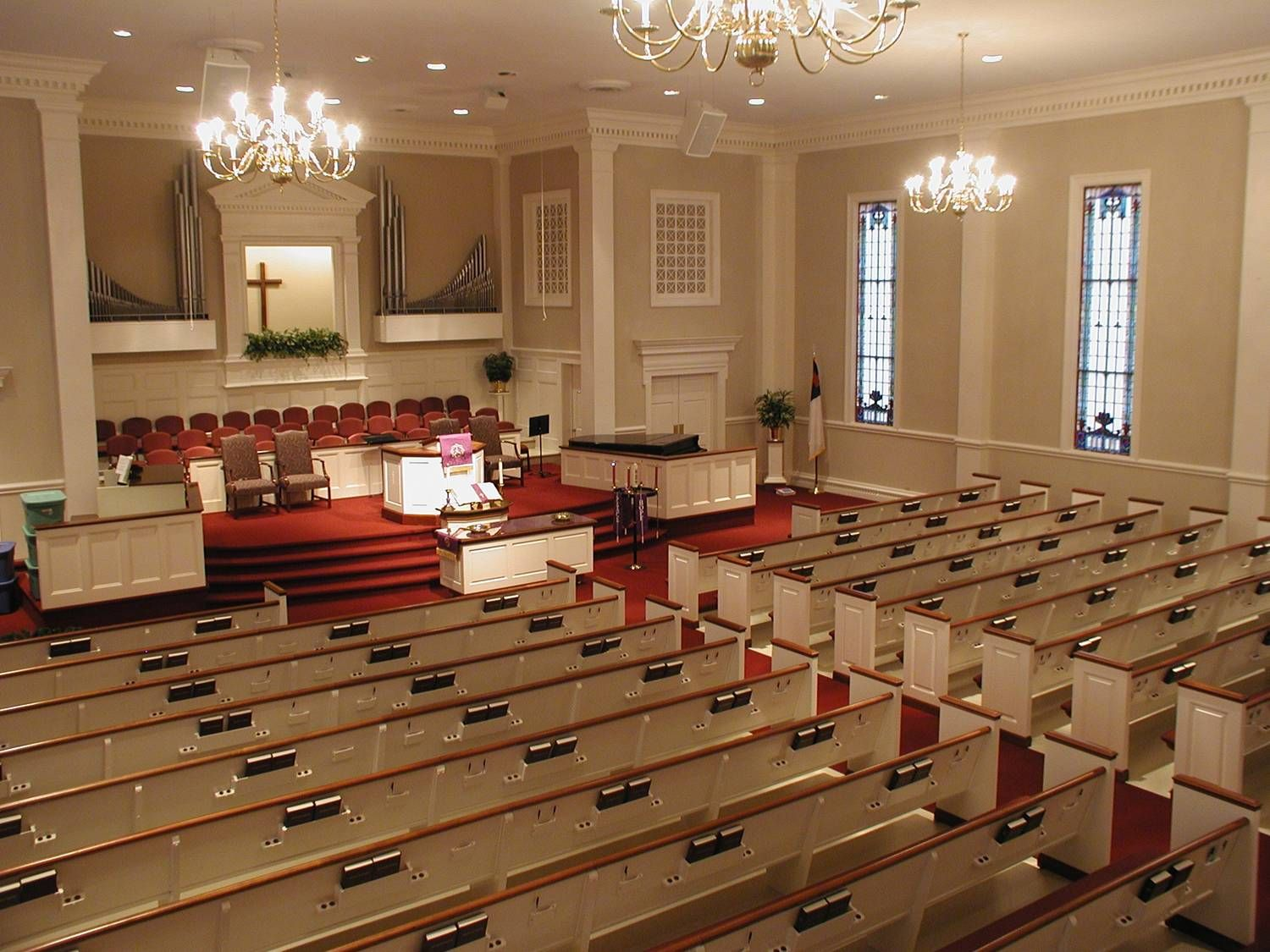Marcel The Shell With Shoes On
Official Trailer HD | A24
Marcel the Shell with Shoes On, Part 1
2010
Marcel the Shell with Shoes On, Part 2
2011
Marcel the Shell with Shoes On, Part 3
2014
* * * * * * *

The Reason ‘Marcel the Shell With
Shoes On’ Will Absolutely Destroy You
NO, NOW YOU’RE CRYING: When our beloved wise-cracking mollusk first went viral, we were at an internet crossroads. We clearly chose the wrong path. The glorious (devastating) new film shows us why.Published Jul. 01, 2022Marcel (the Shell (with Shoes On)) found his way to me during sophomore year of college, back when being online didn’t feel like such a chore.I think it was around 2011. My friend pulled up this video featuring a stop-motion shell equipped with one large googly eye and, naturally, shoes. We watched the video, commented on how many people had seen it, and wrote it off. But throughout the rest of that spring–which turned out to be one hell of a terrible semester–I kept going back to it. Life sucked in that specific way that life is terrible for a 20-year-old, and as it turned out, the remedy was always more shell. So on nights where I’d decided to simply blow off homework, I’d dive into YouTube, eat Domino’s pizza and drink whiskey from a plastic bottle, and find my way, eventually, to Marcel.I feel like over the years people have told me that’s what Marcel became for them, too: a palm-sized, quirky salve whose debut marked this peculiar crux of the internet’s history before the World Wide Web felt so perpetually toxic.The original short film-turned-YouTube video from Dean Fleischer-Camp and Jenny Slate amassed over 32 million views–a bona fide viral video when that kind of thing was still impressive. It spawned two short sequels, and then eventually, we didn’t hear from Marcel anymore. Twelve years went by. 4chan devolved into 8chan (yikes) and TikTok replaced Vine. Social media became an opinion cesspool and the likes of Marcel didn’t seem to have much of a place in the culture anymore, relegated to wherever Charlie the Unicorn and Philosoraptor exist.Then, in the chaos of 2022, A24 announced that it would be releasing a feature-length mockumentary titled Marcel the Shell with Shoes On from Fleischer-Camp. For the die-hard fans, that was terrible news because there’s a certain cringe that often comes along with pulling the past into the present (see: Gilmore Girls: A Year in the Life, Will & Grace, Fear Factor’s Joe Rogan). If anyone should avoid 2022, it’s the perpetually earnest and optimistic Marcel the Shell.The original Marcel the Shell video appeared online at a time that felt like a fork in the road. Marcel is the road we did not travel. We opted instead for something harsher and vitriolic. We lost the good faith that Marcel encapsulated.In a bittersweet twist, Marcel the Shell, as we know him, does not come back. Or rather, it’s not all we see of him. Instead of recreating the past, the film recognizes that no matter which viral fame you’ve achieved–the pure one of 2010 or the infamous one of 2022–there’s a life that’s happening on the other side of the screen.In the 10 years or so since we last saw Marcel, we discover that the two people whose house he lives in have since separated (a presumed nod to the 2016 divorce between Fleischer-Camp and Slate, both of whom, excitedly, returned for the film). In the wake of their departure, Marcel’s shell family has disappeared as well, except for his Nana Connie (voiced by Isabella Rossellini).In the film’s earlier scenes, we get callbacks and quotables from the original short film, but then the movie pivots. Nana Connie has what appears to be signs of dementia. On good days, she gets a bit lost. On bad ones, she gets hurt. Marcel, still squeaky and youthful, has fallen into the role of caregiver. She is insistent that he continues to live his life and find his missing family; he’s determined to stick by her side.In the excitement of gaining internet fame, Marcel and Fleischer-Camp (who cameos in the film as the documentarian) go on a day-long search for Marcel’s family, but when they return, Marcel finds that all the fans who were inspired to help him are mostly interested in grabbing a selfie in front of the house. Dancing on TikTok. Posting something online as a braggy souvenir from when they doxxed Marcel. Worse, inside the house, the commotion has caused Nana Connie to fall and injure herself.The short of it is that Marcel’s life isn’t quite as easy as it once looked online either. Like a lot of us, we look incredible via what we choose to share online. But when Marcel–and again, I’d like to recognize that we’re discussing a shell with a googly eye–is offered to us over the course of 98 minutes, life isn’t easy as it seemed to be in those three minute clips.The film gets at the struggle that comes with grief, but more importantly, how easy it is to get trapped in the incompatible online version of ourselves. At one point in the film, Marcel questions Fleischer-Camp for not sharing any personal details about his life, saying, “You can connect with people when you’re not filming them.”The moment underlines the entirety of the film–regardless of viral fame or the personas we build online, there’s always more going on than the internet suggests. And maybe the reason we lie about it all is because it feels like that’s our own escape. Or that we can create something better than what we’re living. Like Fleischer-Camp, it’s easier to post about what we’re seeing than it is to get into what plagues our day to day. But Marcel the Shell pushes past that. Marcel of 2010 showed us how pure life can be on the Internet. Marcel of 2022 shows us how pure it can be when you log off.For those who’ve seen the film, you know that the whole story culminates in an interview with the fearless Lesley Stahl of 60 Minutes–an offer Marcel initially declines for fear of drawing more attention to himself and endangering Nana Connie. Frustrated at Marcel for turning it down and refusing to accept the opportunity in front of him, she feigns a sudden reversal in health so that Marcel will do the interview. As he and Fleischer-Camp sit before Stahl and do their interview, Nana Connie sits in the window sill, recites “The Trees,” a poem by Philip Larkin, and then when the film cuts back, she is gone.As Marcel tries to make sense of her death a few scenes later, he finds himself drawn to a cracked window. He turns to the camera and explains that he comes there to speak to Nana Connie. The air moving through the crack hits his shell and makes a dull whistle, and he says with a smile, “Suddenly we’re one large instrument.”You’d think, 12 years into the future and squarely in my thirties, this wouldn’t hit me as hard as it might have in my plastic-bottled whiskey drinking days, but I was in the back of the theater, releasing those little mini breaths you run into when you’re trying not to emotionally explode in public. Between sniffs, I heard the fully adult man beside me choking back the same breaths. When the lights came up, I laughed and said, “I’m glad you were the one sitting beside me because I know that you got it,” and he said, “I thought the same thing about you, too.”I’m not entirely sure what I meant by that–maybe that we were two grown men crying at a stop motion shell from the internet. Or that in the era of cynicism and skepticism, we allowed ourselves to cry at this earnest message about grief and life. I suspect it’s probably more in line with why I finally decided I was crying. A special piece of my life found a way to circle back to me a decade later. Not to wax nostalgic about the past but to find me where I needed it, at the same place I was.And yeah, none of this would have come to be had Marcel not been extremely online. But the best part of Marcel’s story–the purest piece that I’ll carry with me–happened when he logged off.
* * * * * * *
The Trees
The trees are coming into leaf
Like something almost being said;
The recent buds relax and spread,
Their greenness is a kind of grief.
Is it that they are born again
And we grow old? No, they die too,
Their yearly trick of looking new
Is written down in rings of grain.
Yet still the unresting castles thresh
In fullgrown thickness every May.
Last year is dead, they seem to say,
Begin afresh, afresh, afresh.
The recent buds relax and spread,
Their greenness is a kind of grief.
Is it that they are born again
And we grow old? No, they die too,
Their yearly trick of looking new
Is written down in rings of grain.
Yet still the unresting castles thresh
In fullgrown thickness every May.
Last year is dead, they seem to say,
Begin afresh, afresh, afresh.
In Praise of the Simple Beauties
of Marcel the Shell with Shoes On
Olivia Rutigliano on the New Movie
about the Internet's Favorite Anthropomorphic Mollusk
July 1, 2022
This week, I saw a dear old friend at the movies and I am pleased to say that he seems better than ever.I first became acquainted with the character known as “Marcel the Shell” in my college dorm room nearly a decade ago. My sister had sent me a link to a popular YouTube video, a short stop-motion film in which a tiny seashell with a googly eye and a pair of pink plastic sneakers takes a cameraman around the house where he resides—a giant house, a human’s house—and explains how he lives his miniature life.He exists inventively, resourcefully. He scrounges for things that he might turn into tools and gadgets and furniture. “Guess what I use as a beanbag chair?” he asks the filmmaker capturing him. “A raisin.” He uses stray hairs as string, pretends a ball of lint is his pet dog. Most of the film is like this: a little vérité-style preview into this charming lifestyle which is a dilated, cobbled-together version of our own.Crucially, this short—entitled Marcel the Shell with Shoes On and made by Dean Fleisher-Camp and Jenny Slate—is not about a little world as much as it is about a little life. The immense charms of Marcel’s handmade (shellmade?) surroundings are surpassed by the palpable spunk of its resident. Marcel is curious, sentimental, indefatigable, and a little bit sassy. He informs the camera, “Some people say my head is too big for my body… and I say… ‘compared to what?'”Marcel is able to produce beauty in his world by seeing everyday objects in a different way, and so too does the film.The original Marcel the Shell short, posted to YouTube in 2010, became a phenomenon. The lore is that Slate and Fleisher-Camp had created him accidentally—she produced the funny voice, and he built a model to match. Indeed, Slate speaks about the character not as something she and Fleisher-Camp created, but as a whole identity who was inside both of them and managed to manifest from them, like Athena climbing out fully grown from Zeus’s head or Aphrodite emerging as her adult self from, well, a shell. Marcel is his own person, a fully coherent individual, even to his creators.In real life, Marcel drew crowds and fans for his cuteness but held onto them because of his unique perspective. The popularity of the initial short video generated several sequels and two children’s books. And now, 12 years later, he has finally made his feature film debut.Directed by Dean-Fleisher Camp, co-written by Jenny Slate and Nick Paley, and produced by A24, this feature version, also entitled Marcel the Shell with Shoes On, revisits the last few years of Marcel content while also reworking it. The story is about Dean, a filmmaker, who finds a tiny sentient shell living in the Los Angeles Airbnb he’s staying in, and gets the idea to film his daily routine. Marcel lives with his loving grandmother, Nana Connie (Isabella Rosselini), and they spend their days gardening, talking, watching 60 Minutes on Sundays, and rigging contraptions to get basic things done. “It’s pretty much common knowledge that it takes at least 20 shells to have a community,” Marcel informs Dean. But it’s just him and Nana Connie in the house—the rest of their giant group has vanished (probably accidentally packed in a suitcase and taken away by the last couple to stay there).What results is a tender 89-minute film about the bonds that fortify our lives, from new friendships to intergenerational care.In the film, the shorts that Dean has posted to YouTube make Marcel a kind of celebrity, and he decides to try to use his newfound notoriety to find his missing family. But his attentions are split between the longing to find his community and the desire to care for the one he already has: Nana Connie seems to be experiencing a kind of dementia, and Marcel, ever-loving, wants to use all his energy caring for her and keeping her safe. The life they live together is special and beautiful, and he doesn’t want to miss a minute of that.What results is a tender 89-minute film about the bonds that fortify our lives, from new friendships to intergenerational care.Marcel wonders a lot about the different ways we connect to people; the discovery of the internet has him negotiating the difference between a community and an audience. Narratively, it is about what it means to build a life with someone, but it’s peppered with questions like these.And thematically, of course, Marcel the Shell with Shoes On cannot help but be about our relationships to objects, too. So much of the film is about Marcel’s material life and his practical mindset: how he uses objects to make his life easier (for example, he climbs inside a tennis ball and uses it to traverse the house).But it is also about how Marcel’s inch-tall perspective opens up the potential of objects and materials—not just pragmatically but aesthetically. Marcel is able to produce beauty in his world by seeing everyday objects in a different way, and so too does the film. Some of the most beautiful moments are simple, silent camera shots over the tiny treehouses built in the Airbnb’s planters, or a pattern (made with arugula leaves, flower buds, and green peas) Marcel arranges into the dirt in a window box outside. And then there is Marcel himself, this little anthropomorphic mollusk (I guess?) with his own special kind of wisdom, reminding us the ways in which even things around us are all creatures, great and small.I find myself, after this particularly trying week in America, grateful to be seeing Marcel again.One of the film’s many, many motifs is a reminder to pause and notice the beauty of the world around us—to live slowly and receptively, to stop and realize that we are all, in our ways, so small, and to remember the ways our lives can still make big impacts. But more than this, the film is clear that we are all (in a way) objects, all instruments. We are vehicles for beauty and love, if we only open ourselves up and let them flow through us.This might seem trite, but if it does, that is my fault. I find myself, after this particularly trying week in America, grateful to be seeing Marcel again, shining in all his sincere glory from inside the most profound iteration of his chronicle yet. I am desperate to impart the splendidness and the earnestness of this achievement, committed to illuminating others to the wonders of this movie, candid about his ever-present perch in my heart but adamant that this film will appeal even to those who have never seen him before.The film is genuine, never-cloying, always poignant. Nearly every shot is suffused with soft, golden sunshine and an ever so hazy, dreamlike grain. It is a warm, delicate, perfect project—a beautiful revisitation of and tribute to a character so surprisingly special and plucky that his relevance has outlasted a decade of changing popular cultural norms. Through everything, no matter what else there is, we are reminded that there is Marcel, there is Marcel, and there will always be Marcel.
* * * * * * *
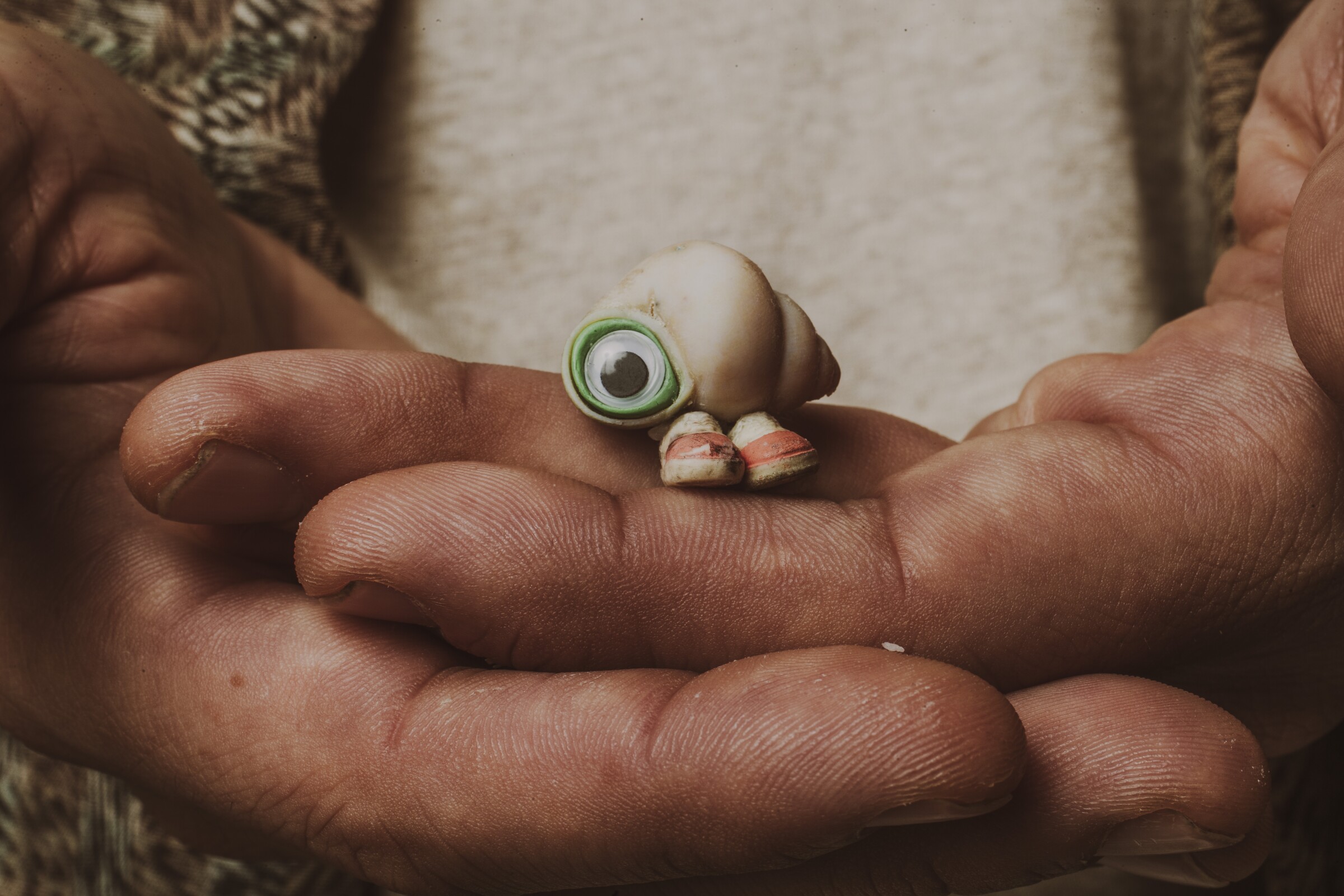 |
| Dean Fleischer Camp, director for “Marcel the Shell with Shoes On,” holds Marcel in his hands. (Allen J. Schaben/Los Angeles Times |
How ‘Marcel the Shell’ went from viral sensation
to 2022’s most adorable movie star
(Allen J. Schaben/Los Angeles Times)
June 24, 2022
Minuscule in mass but colossal in charm, Marcel, a one-eyed mollusk with a pair of pink sneakers attached to his exoskeleton, became an online sensation in late 2010. That’s when filmmaker Dean Fleischer Camp and comedian and actor Jenny Slate, then a couple, unleashed his irresistible persona in a stop-motion short film on YouTube.
Over a decade later, following two more viral videos, their adorable brainchild now stars in the full-length mockumentary “Marcel the Shell With Shoes On,” which A24 is releasing exclusively in theaters this weekend. But the journey from the no-budget original shorts to the feature adventure, which premiered at the 2021 Telluride Film Festival, involved plenty of tiny but assertive steps.
The origins
Marcel’s childlike voice, where his heart-melting power resides, is Slate’s creation. She first summoned the soft-spoken tone during a trip for a friend’s wedding 12 years ago. To save money, she and Camp were sharing a hotel room with several people.
“I was feeling really cramped and I just started talking in this little voice, and we all thought it was funny,” Slate told The Times ahead of the film’s release. That playful impulse would soon take the shape of the now-beloved character known for sharing unexpectedly profound existential observations from a refreshingly clear-sighted perspective.
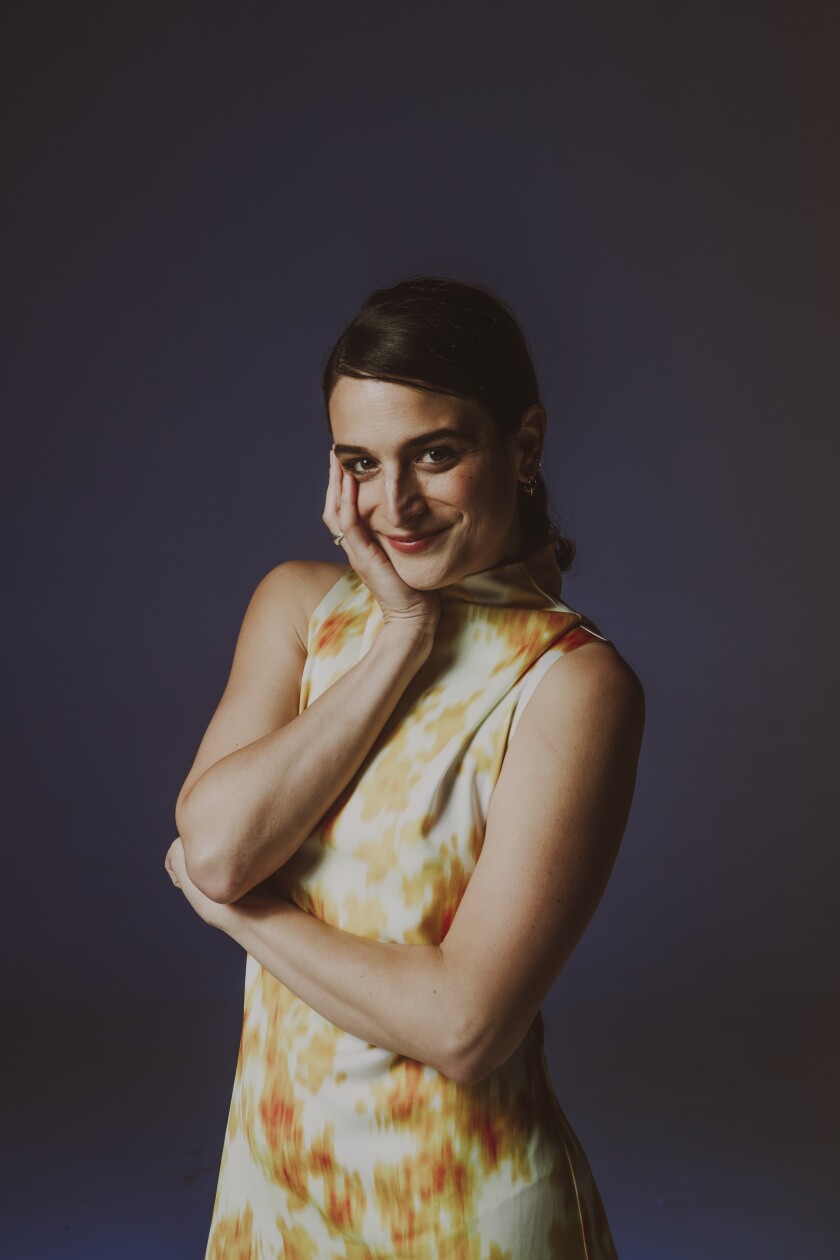 |
Jenny Slate conceived the voice of Marcel over a decade ago. (Allen J. Schaben/Los Angeles Times) |
When the weekend was over, a panicked Camp remembered a promise to make a video for a friend’s stand-up comedy show. He immediately thought of interviewing Slate in that new voice and began building an idea around it. After recording the lines, he proceeded to handcraft a figure to personify them.
“Dean did such beautiful character design. When I saw Marcel standing on the kitchen table, I just felt so sure that that was him, like how people feel when they are in love at first sight,” noted Slate. “That’s how I felt about Marcel.”
Without previous knowledge of the stop-motion animation process, the director created the character, animated it, edited the scenes and screened Marcel’s first-ever appearance — all within 48 hours. At the time a self-proclaimed perfectionist, Camp had no intention to upload the short piece online until someone at the show inquired about the possibility of showing the wondrous sea creature to their grandmother.
“Now I derive a lot of meaning from the fact that he’s a shell, but back then, I was just trying to make a small, cute character out of found objects,” he said. “There’s an emotionality to that voice that I think I was trying to embody by using objects that you might find under your couch or in the back of a drawer. That was the impetus for it creatively.”
Slate can trace that interest in the inner lives of inanimate objects to a series of comedic videos, made long before Marcel came to be, where a variety of items narrate their lives or sing about their feelings. “One that I still love is of a container of powdered milk singing a tragic song about how nobody wants to use it because it’s not real milk. And that it’s very lonely,” she said with a laugh.
Since Marcel lives in the human world, Slate said that one of the major joys of creating his microcosms lies in repurposing household items from their intended use for his everyday activities. “I love figuring out how Marcel does things or what he wears for what. Suddenly all the objects around me are imbued with such possibility,” she said.
 |
In “Marcel the Shell with Shoes On,” Marcel watches as he becomes an internet sensation. (Courtesy of A24) |
How ‘Marcel’ became a movie
As Marcel’s short films went viral online, Hollywood studios and networks approached Camp and Slate. The duo took the meetings, but were wary of attempts to attach Marcel to a more familiar tentpole template.
“I remember somebody suggested that we partner Marcel with Ryan Reynolds so they could fight crime. I’m not saying I wouldn’t watch that movie, but I just knew that was not the right avenue to pursue for him,” he recalled. “I wanted to make a movie that was personal and did justice to the internet love for this character. We knew after that round of meetings, ‘If we’re going to expand Marcel, it needs to be made independently.’”
Even before a movie was on the horizon, the co-creators published two books illustrated by artist Amy Lind: “Marcel the Shell With Shoes On: Things About Me” in 2011 and “Marcel the Shell: The Most Surprised I’ve Ever Been” in 2014. For Slate, the second tome represented a breakthrough in the development of the character’s emotional complexity.
“That one not only goes deeper into exploring Marcel’s perspective as a very small creature, but also begins to show his philosophy on life and what his preferences are,” said Slate. “We really get to know him and there are sweet little musings in there.”
Through it all, Camp and Slate continued collecting ideas and jokes for a possible feature film, without any specific story angle.
With time, the two realized that what they found compelling about Marcel directly related to their own preoccupations, such as the internet fame that their creation had amassed. That’s when Marcel’s journey to the big screen began to crystallize.
 |
Dean Fleischer Camp, director & writer of “Marcel the Shell with Shoes On.” (Allen J. Schaben/Los Angeles Times) |
Joining creative forces with co-writer Nick Paley, the team wrote a long treatment and started hosting recording sessions where Slate would give form to Marcel’s dialogue with spur of the moment ingenuity. Based on what those improvisation meetings yielded, Camp and Paley slowly polished and rerouted the plot.
“They would put together a patchwork of transcription of recorded audio and then write new scenes. Then we would record off of those written new scenes and improvise off of them too,” said Slate. “Most of the film is highly improvised, while some parts were word-for-word written out, depending on what Dean and Nick decided to do.”
“We were writing and recording for two and a half years, but probably 10 to 12 days of that we were recording audio periodically,” added Camp. “We’d record with Jenny again, she’d give us all this new, great material, and then we would incorporate it into the script.”
During this process, renowned actress and filmmaker Isabella Rossellini came aboard to voice Marcel’s wise and cheeky grandmother, Nana Connie. Fleischer-Camp had been fascinated with the series of peculiar short films Rossellini created for the Sundance Channel in the late 2000s titled “Green Porno,” focused on animal behavior and mating rituals.
“She’s more like Nana Connie than I think any other role she’s played. She has an inner strength and a real mettle to her,” he said. “She also knows a ton about farming. She lives on a farm that she works with several other people.” (Some of the audio of Nana Connie talking about her strawberries in the finished film comes from the director’s interview with Rossellini about her real-life crops.)
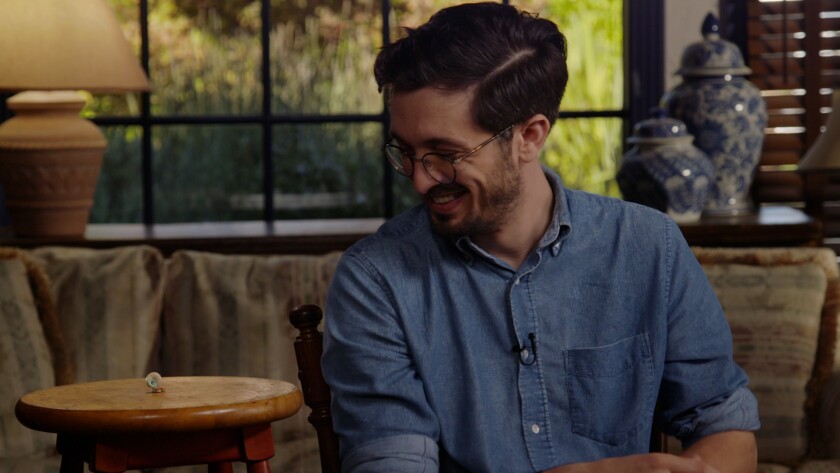 |
Dean and Marcel the Shell | (Courtesy of A24) |
Dean plays himself
As with the short films, which were framed as nonfiction shorts about Marcel made by a filmmaker named Dean, Camp knew his voice would also feature in the larger project. But he wasn’t keen on appearing in front of the camera as a somewhat fictionalized version of himself.
“It wasn’t part of the original pitch. Although going in, we did have the idea that Dean would evolve in this way and that Marcel would sort of push him out of his comfort zone,” he said. “Dean would have to confront artistic, but also personal questions on role of the director. ‘How much do you help a documentary subject when they’re in need?’ ‘What does that relationship consist of?’ Those got explored as a result of making the film.”
As Slate notes, Marcel also ponders the cause and effect of what it means to be filmed. The short films that made him famous in our reality also exist in the feature as documentaries, and Marcel is aware of them and affected by their success and fandom.
“He had thought he was just in conversation. But then, the short films that the filmmaker Dean puts online end up affecting him. They affect his point of view,” said Slate. “They affect what he thinks is possible. They cause him to hope when hope is often painful. We see all of that because Marcel continues to engage.”
Eventually the director gave in to playing Dean on camera — and the character has a fuller arc examining the ethics of his relationship with the endearing shell. Camp even factors into an interview with Lesley Stahl and the “60 Minutes” crew — Marcel and Nana Connie are devoted fans of the investigative show.
The movie’s Dean is also processing a recent romantic breakup. That this separation was written as part of the tale even before Camp and Slate divorced in 2016, seemed curiously prophetic to the filmmaker.
“I love how much I find in the film and in the story and in the character that feels somewhat unintentional or at least feels subconscious,” he said. “I’m an idiot because I always think that whatever I’m making is just total fiction. Then years later I’m always surprised at how personal my movies end up, and this one is no exception.”
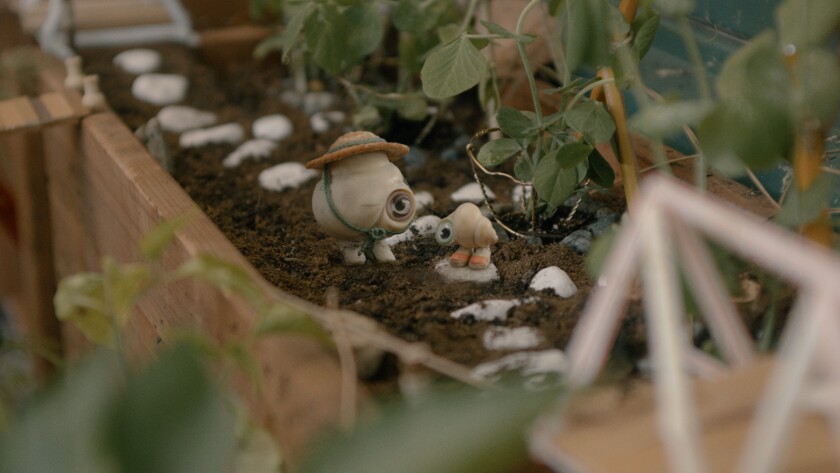 |
| Marcel and his Nana Connie in "Marcel the Shell with Shoes On." (Courtesy of A24) |
What comes next
With Marcel now warming souls in movie theaters, Slate feels confident that this ever-deepening character has a promising, if still undecided, future.
“As long as I’m a living person there will be more to explore about Marcel because there’s a big part of him that really lives in my psyche,” she said. “He’s exactly the same as when we first met him. He’s just revealed himself more. The best thing about Marcel is that he very rarely says he doesn’t want to answer a question. That’s why we keep getting to know him.”
Slate and Camp agree that the years alongside their lovably witty artistic offspring has elucidated significant truths about themselves, all while teaching them invaluable lessons in tackling adversity.
“I find Marcel truly inspiring, especially the way that he never feels small, even if he is. He never feels overlooked. He never feels like the world is unfair. Most people can relate to feeling like they are in a world that wasn’t made for them,” said Camp. “But he doesn’t see his differences. When he runs into an obstacle, he doesn’t see impossibility. He’ll find a way around it just like yesterday and just like tomorrow.”
 |
| Rosa Salazar, Dean Fleisher-Camp, Jenny Slater |
Cast of Marcel the Shell
Guess why I smile? Uh, because it's worth it.
- Marcel the Shell

Guess what I do for adventure... I hang glide on a Dorito.
- Marcel the Shell
Dean Fleischer-Camp
Dean
But sometimes I tie a hair to a piece of lint and I drag it around.
His name is Alan. He doesn't know tricks or anything.
- Marcel the Shell
Isabella Rossellini
Connie
Life's a party. Rock your body."
-Marcel the Shell
Nathan Fielder
Justin
You can't make yourself a nickname,
like you can make yourself a new hairstyle.
- Marcel the Shell
Rosa Salazar
Larissa
One time I nibbled on a piece of cheese
and my cholesterol went up to 900.
- Marcel the Shell
Thomas Mann
Mark
Do you want to watch me try to lift this?
Alright... ehheh, ehh, ughh...
Nah, I can't. I can't' life anything up at all.
- Marcel the Shell
Lesley Stahl
herself
My one regret in life is that I'll never have a dog.
-Marcel the Shell
Jessi Klein
Judy
Marcel The Shell With Shoes On
Official Trailer (2022) Jenny Slate, Rosa Salazar


